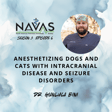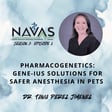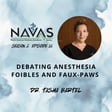
Unveiling Nocita: A Breakthrough in Post-operative Pain Relief with Dr. Tammy Grubb - Ep. 10
Here on the NAVAS podcast, we are recognizing and honoring September as Animal Pain Awareness Month by giving our listeners a small taste of a larger episode on pain assessment that will come out later this month with Dr. Tammy Grubb. As a board-certified veterinary anesthesiologist who is an expert in companion animal pain management and an intense fan of local anesthetic agents, Dr. Grubb provides her incite and expertise on the groundbreaking drug, Nocita. Together with host, Dr. Bonnie Gatson, they will dive into Nocita’s mechanism of action, address safety concerns, discuss its use in various clinical circumstances, and touch on some of the controversies of its use as part of an analgesic plan. We hope you have 15 minutes to spare to learn how to incorporate Nocita into your daily anesthetic practice.
Learn more about Nocita.
Learn more about Animal Pain Awareness Month.
We invite our listeners to check out articles mentioned in today’s episode, including this manuscript comparing the use of Nocita to bupivacaine for dental blocks and a two-part review article authored by Dr. Grubb about the use of local anesthetics in dogs and cats.
Part 1 and Part 2
If you like what you hear, we have a couple of favors to ask of you:
- Subscribe to the North American Veterinary Anesthesia Society (NAVAS) for access to more anesthesia and analgesia educational and RACE-approved CE content.
- Spread the word. Share our FB or IG posts, re-tweet, post something on a network or a discussion forum, or tell a friend over lunch. That would really help us achieve our mission: Reduce mortality and morbidity in veterinary patients undergoing sedation, anesthesia, and analgesia through high-quality, peer-reviewed education.
Thank you to our sponsor, Dechra - learn more about the pharmaceutical products Dechra has to offer veterinary professionals, such as Zenalpha.
If you have questions about this episode or if you want to suggest topics for future episodes, please reach out to the producers of this podcast at education@mynavas.org. Please consider subscribing, liking, leaving this podcast a review, or even telling your friends to give this podcast a listen. We appreciate any and all listener support!
All opinions stated by the host and their guests are theirs alone and do not represent the thoughts or opinions of any corporation, university, or other business or governmental entity.
The NAVAS Podcast is published monthly on or near the 15th of the month.
Special thanks to Chris Webster of Chris Webster Productions for editing, producer Maria Bridges, and Saul Jimenez for IT support in making this podcast a reality.










